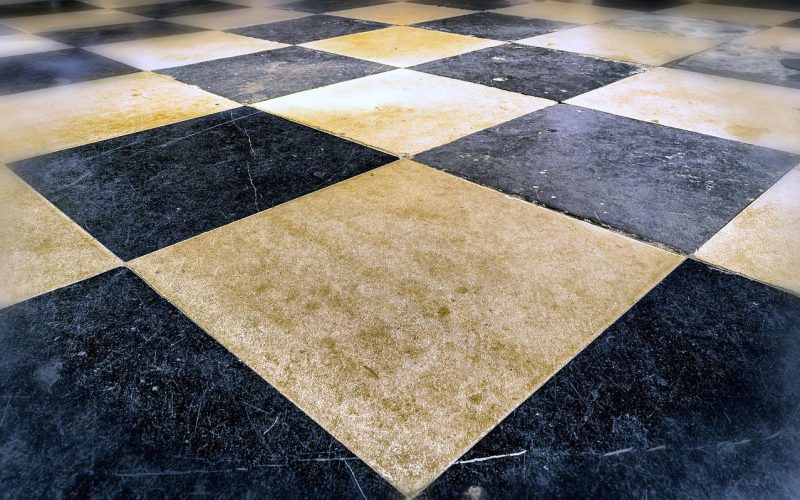When choosing the best flooring, homeowners should know the many tile types available. Nowadays, homeowners prefer to incorporate aesthetics into every aspect of their homes, including the flooring.
When looking for an appropriate form of flooring, tiles provide long-lasting beauty, functionality, durability, and several other benefits over other flooring options.
They are simple to maintain, have a longer lifespan than other flooring varieties, and require no additional expert maintenance.
However, floor tiles are no longer just for ‘wet places’ like bathrooms. People are using similar finishes in various other areas of their homes.
The different types of tiles available today are mind-boggling, especially considering the sub-categories. However, we can simplify the matter.
However, because of the wide range of attractive designer tiles, they’re no longer limited to bathrooms and kitchens.
The sheer variety of floor tile kinds can surprise you if you’ve never done tiling tasks before. Tiles are differentiated based on the section of the house You will use for them and the material, size, and style.
Don’t let this overwhelm you; here’s a fast, one-stop primer on the different types of flooring tiles you should be familiar with.
1. Ceramic Tiles
Ceramic tiles are among the most popular clay-based tiles on the market. They are mined, processed, and molded before being used. Their ability to blend in with practically any type of interior design will astound you.
Ceramic tiles’ most notable characteristics include their extended lifespan, various applications, and strong resistance to scratches and abrasion.
Thanks to their durability, ceramic tiles can sustain years of steady foot traffic and provide diverse design options. They also have matchless patterns and hues and are usually covered in a durable finish.
Furthermore, ceramic tiles, on the other hand, should not be used outside since they cannot withstand heat and do not adapt well to the freezing temperatures of winter. They also tend to absorb water.
2. Porcelain Tiles
Although the distinctions between porcelain and ceramic tiles are minor, they exist. As a result, many people mistake porcelain tiles for ceramic tiles.
Porcelain tiles are denser clay than ceramic tiles and are fired at much greater temperatures than ceramic tiles. Also, this, of course, makes them more durable and damage-resistant.
Porcelain tiles can also be utilized in severe temperatures because of excellent resistance to first and low porosity.
Furthermore, Porcelain tiles are available in both polished and unpolished finishes, making them suitable for various household and commercial uses (with light foot traffic). Glazed porcelain tiles are also available, but they are not as durable. This is one of the different types of Tiles.
3. Quarry Tiles
According to its name, Quarry tiles aren’t made at the many quarries that dot the United States; instead, they’re made by grinding together elements like feldspar, clay, and shale and then molding them into tiles.
Because of these minerals, quarry tiles are now in the same league as the harder flooring tiles. Because of their low porosity, quarry tiles can be utilized indoors and outdoors.
4. Mosaic Tiles
Mosaic tiles are pretty popular in tiny spaces like kitchens and baths. These are tiles that have a smaller surface area. The length and width of each tile are both less than 2 inches.
As a result, they’re simpler to set up in smaller spaces. Using the correct cutting tools, on the other hand, leads to a superb result. A RUBI tile cutter is one of the best cutting tools because it cuts exceptionally.
Furthermore, mosaic tiles are frequently used in bathrooms, kitchens, worktops, and flooring but can be used anywhere. They don’t chip easily and are stain—and moisture-resistant, making them suitable for indoor and outdoor use.
Also, they’re easier to clean, and the grout lines provide texture and make them more slip-resistant than other tiles.
These tiles can be the most appealing if you appreciate complicated patterns and colors. Some of these tiles have even been used to make light switches. This is one of the different types of tiles.
5. Marble Tiles
Marble tiles are an excellent alternative to add aesthetic value and refinement to your property. They’re made of real marble, which is highly durable.
Marble tiles are available in practically every hue due to the variety of components removed.
Marble tiles, on the other hand, come in various finishes, including brushed, polished, honed, tumbled, and more, making them excellent for any room.
On the other hand, Marble tiles are porous and susceptible to stains and spills. As a result, they are rarely utilized outside.
However, employing a suitable surface sealer before installation can help to reduce its porosity. The sealer clogs the pores as an invisible protective covering on the tile surface.
Furthermore, marble tiles are a costly alternative, so you must include the costs of installing them as flooring.
6. Granite Tiles
If you plan to put tiles in a high-traffic location, granite tiles are the best choice. They’re made of granite, a dense and durable igneous rock.
This rock’s speckled minerals and distinctive veining set it apart from other materials, but their combination ensures that no two granite surfaces are alike.
Granite tiles have a fantastic reputation in the flooring market due to this. Luxurious establishments are strongly demanded since they come in various colors and have great aesthetic value.
Furthermore, the scratch-resistant surface is aided by the natural and durable material utilized. Granite tiles are light and tiny, making them easy to deal with. They are also acid-resistant. This is one of the different types of tiles.
7. Travertine Tiles
Travertine tiles are made of travertine limestone found in hot springs, natural artesian springs, and caverns worldwide.
The material comes in various hues, has pits, and has a rough texture caused by air bubbles and organic materials. Travertine tiles have a beautiful surface that illuminates and gives your interior area a natural appeal.
The endurance of the travertine material can be measured by the fact that you can use it to build the ancient Roman structures that can still be seen in Italy today. As a result, travertine tile is an excellent choice for temples, sculptures, and theaters.
Furthermore, it is now widely used to construct pathways, restrooms, pool decks, and other areas with extensive water exposure.
Travertine is a 100 percent biodegradable material that is good for the environment. It’s also durable and easy to repair.
8. Slate Tiles
Slate tiles, another common material for tile flooring, are made from natural mineral deposits and are incredibly durable while remaining naturally beautiful.
The cloth can help keep a room warm and is highly slip-resistant due to its natural, gritty texture. Also, Slate tiles are less expensive than granite and marble, yet they are still more expensive than ceramic tiles. Slate tiles are one of the different types of tiles.
9. Terrazzo Tiles
Terrazzo tiles are made of various materials, including glass, quartz, marble, and granite. Polishing, curing, and grounding are all steps in the preparation process, resulting in a resilient, smooth, appealing, and shining tile, making it a popular choice for public buildings.
Furthermore, despite their beauty, terrazzo tiles may not be the greatest choice for residential flooring due to their slickness. To help alleviate this problem, you should investigate the wide variety of carpets available.
10. Onyx Tiles
Onyx tiles resemble marble tiles because they are made of onyx, a calciferous stone with a beautiful translucence. The stone’s high mineral density gives it this distinct appearance, making it an excellent choice for living spaces.
However, because these stones are highly delicate, materials such as fiberglass, mesh, and resin are used to strengthen them. Their unique surface shapes determine the utilization of these stones.
These stones come in various colors and are popular indoors due to their light coloration. Onyx tile preparation and installation necessitate a high level of expertise, which drives the price. This is one of the different types of tiles.
11. Hardwood Tiles
Hardwood flooring tiles are well-known for their ability to increase the value of a home. Due to the non-depreciating value of wooden floors, the value of a home improves as soon as a homeowner installs hardwood on their floors.
Hardwood floors, unlike other surfaces, do not need to be replaced every few years and are simple to clean and care for once installed.
Unlike many other forms of flooring, hardwood tiles do not display stains or grime. Hardwood floors are built to endure a lifetime, even if they exhibit wear signs.
Furthermore, Hardwood tiles are very popular among first-time buyers. Installing hardwood floors in your new house gives your living area your taste and personality without further effort. Hardwood-floored homes are trendy.
12. Faux Wood Tiles
The faux wood tiling style is the most significant trend in the flooring market. It combines the natural beauty of several kinds of wood with the durability of tiles.
Faux wood is more durable and water-resistant than hardwood, and it comes in infinite designs. It is also termite-free and requires minimal upkeep.
The tiles appear to be made of wood, but they are constructed of ceramic material. For various reasons, faux wood tiles are quickly replacing hardwood.
While hardwood flooring is often harmed by foot traffic and furniture movement, imitation wood flooring is highly scratch-resistant.
As a result, they’re great for high-traffic areas where they’ll survive for decades if not a lifetime. This is one of the different types of wooden tiles.
13. Quartzite Tiles
Quartzite is a metamorphic rock that provides a natural yet attractive appearance for flooring. The stone is formed when high temperatures and pressures are applied to quartz-rich sandstone.
It is famous for flooring tile applications in homes, particularly in the kitchen, due to its excellent durability, attractiveness, and strong slip resistance.
Also, you won’t have to worry about microorganisms or bacteria getting through because this material’s non-porous structure keeps liquids out.
In addition, Quartzite tiles are ideal if you want to give your home a premium look and don’t want to spend so much money because the stone is less expensive than other stone types.








